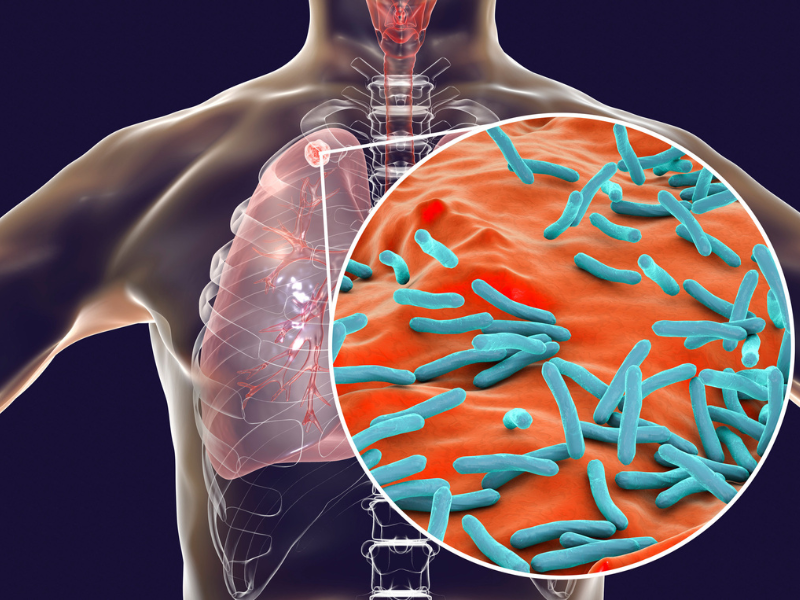Tuberculosis

Tuberculosis (TB) is a serious infectious disease. It typically attacks the lungs, but can also impact other parts of the body such as the brain, kidneys, or spine. It is caused by the bacterium Mycobacterium tuberculosis.
Transmission of TB occurs through the air when an infected person coughs, speaks or sneezes. People with weakened immune systems, such as those with HIV, are more susceptible to contracting TB.
TB is a significant global health issue. It affects millions of lives and poses a threat to public health. The World Health Organization (WHO) reports that one-third of the world’s population has a latent TB infection. They have the bacteria but are not sick or contagious. However, they could get sick with TB later.
What are the symptoms of tuberculosis?
The symptoms of TB disease include:
· coughing that lasts for more than three weeks
· chest pain
· coughing up blood
· fatigue
· fever
· night sweats
TB can also cause:
· weight loss
· loss of appetite
· swelling in the neck
If left untreated, TB disease can be fatal. Recognizing these signs early is crucial for timely diagnosis and treatment.
Types of Tuberculosis
A TB infection does not necessarily result in illness. The disease is divided into several stages and forms:
· Primary TB is the initial stage of a TB infection. Your immune system may combat the germs, but sometimes they persist. You might not show symptoms or experience flu-like signs.
· Latent TB occurs when your immune system prevents the spread of germs. There are no symptoms and no contagion. However, the infection remains and can become active in the future. If at high risk, preventive medications may be prescribed.
· Active TB results in germ multiplication, making you sick and contagious. About 90% of adult active cases originate from latent TB.
· Extrapulmonary tuberculosis refers to infection spread outside the lungs. Symptoms may depend on the affected body part.
Causes of Tuberculosis
Tuberculosis bacteria transmit through the air, much like a cold or the flu. You can only contract tuberculosis if you come into contact with someone who has it.
When someone with TB coughs, talks, sneezes, sings, or laughs, they expel tiny droplets containing the germs. If you breathe in these germs, you can contract the sickness. This is why patients with active tuberculosis in their lungs or throat have a higher risk of infecting others. If you have tuberculosis in another part of your body, you are unlikely to spread it.
Tuberculosis is not easy to contract. You’re more likely to catch it from coworkers, friends, or family members with whom you spend a lot of time indoors.
TB risk factors
Some people develop TB disease soon after infection. Others get sick years later when their immune system is weak. About 5-10% of infected people who don’t get treated will get sick later.
High-risk groups include:
· Recently infected with TB bacteria
· Immigrated from areas with high TB rates
· Close contact with TB patient
· Children under 5 with positive TB test
· High TB transmission groups (drug users, homeless, HIV)
· Work or live with high-risk groups
People who have medical conditions that weaken their immune system:
- Substance abuse
- HIV infection (the virus that causes AIDS)
- Silicosis
- Severe kidney disease
- Diabetes mellitus
- Low body weight
- Head and neck cancer
- Organ transplants
- Medical therapies, including corticosteroids or organ transplants.
- Providing specialized treatment for rheumatoid arthritis and Crohn’s illness.
Treatment and Prevention
Treatment for TB involves taking multiple antibiotics for an extended period, usually six to nine months. It is essential to complete the full course of treatment to ensure that the bacteria are eliminated and to prevent the development of drug-resistant strains.
Treating tuberculosis depends on the type of infection:
1. For latent TB, medication like isoniazid, rifampin, or rifapentin is prescribed to prevent it from becoming active. The treatment lasts 3 months or more.
2. Active TB is treated with a combination of medicines including:
· Ethambutol
· Isoniazid
· Pyrazinamide
· Rifampin
The course usually spans 6 to 12 months.
3. Drug-resistant TB may require different medicines. Treatment may extend up to 30 months, with potential side effects. If active TB symptoms appear, contact your doctor promptly.
The Role of Vaccination
The Bacillus Calmette-Guérin (BCG) vaccine, although imperfect, remains a crucial tool in preventing severe forms of TB, particularly in children. Research continues to explore more effective vaccines, highlighting the importance of ongoing investment in TB vaccine development.
Tuberculosis remains a significant health challenge worldwide. However, it is both treatable and preventable. If you suspect TB, consult your doctor promptly. If diagnosed, take precautions to safeguard others and ensure you finish your treatment.



